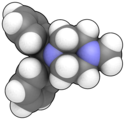 | |
 | |
| Clinical data | |
|---|---|
| Trade names | Marezine, Valoid, Nausicalm, others |
| AHFS/Drugs.com | Consumer Drug Information |
| Pregnancy category |
|
| Routes of administration | By mouth, IM, IV |
| ATC code | |
| Legal status | |
| Legal status |
|
| Pharmacokinetic data | |
| Metabolism | N-demethylated to inactive norcyclizine[1] |
| Elimination half-life | 20 hours |
| Identifiers | |
| |
| CAS Number | |
| PubChem CID | |
| IUPHAR/BPS | |
| DrugBank | |
| ChemSpider | |
| UNII | |
| KEGG | |
| ChEBI | |
| ChEMBL | |
| CompTox Dashboard (EPA) | |
| ECHA InfoCard | 100.001.314 |
| Chemical and physical data | |
| Formula | C18H22N2 |
| Molar mass | 266.388 g·mol−1 |
| 3D model (JSmol) | |
| |
| |
| (verify) | |
Cyclizine, sold under a number of brand names, is a medication used to treat and prevent nausea, vomiting and dizziness due to motion sickness or vertigo.[2] It may also be used for nausea after general anaesthesia or that which developed from opioid use.[2][3] It is taken by mouth, in the rectum, or injected into a vein.[3][4]
Common side effects include sleepiness, dry mouth, constipation, and trouble with vision.[5] More serious side effects include low blood pressure and urinary retention.[5] It is not generally recommended in young children or those with glaucoma.[2][6] Cyclizine appears to be safe during pregnancy but has not been well studied.[7] It is in the anticholinergic and antihistamine family of medications.[3][6]
Cyclizine was discovered in 1947.[8] It is on the World Health Organization's List of Essential Medicines.[9] In the United States it is available over the counter.[6]
- ^ "DrugBank: Cyclizine. Pharmacology: metabolism". DrugBank Database. Archived from the original on 30 January 2016. Retrieved 5 January 2016.
- ^ a b c "Cyclizine 50mg Tablets - Summary of Product Characteristics (SPC) - (eMC)". www.medicines.org.uk. 27 March 2015. Archived from the original on 20 December 2016. Retrieved 13 December 2016.
- ^ a b c Feldman M, Friedman LS, Brandt LJ (2015). Sleisenger and Fordtran's Gastrointestinal and Liver Disease: Pathophysiology, Diagnosis, Management. Elsevier Health Sciences. p. 218. ISBN 9781455749898. Archived from the original on 20 December 2016.
- ^ World Health Organization (2019). World Health Organization model list of essential medicines: 21st list 2019. Geneva: World Health Organization. hdl:10665/325771. WHO/MVP/EMP/IAU/2019.06. License: CC BY-NC-SA 3.0 IGO.
- ^ a b "Cyclizine Side Effects in Detail - Drugs.com". www.drugs.com. Archived from the original on 21 December 2016. Retrieved 13 December 2016.
- ^ a b c "Cyclizine: Indications, Side Effects, Warnings - Drugs.com". www.drugs.com. Archived from the original on 21 December 2016. Retrieved 13 December 2016.
- ^ "Cyclizine Use During Pregnancy | Drugs.com". www.drugs.com. Archived from the original on 21 December 2016. Retrieved 13 December 2016.
- ^ Williams P (2010). The story of the Wellcome Trust : unlocking Sir Henry's legacy to medical research. Hindringham: JJG. p. 14. ISBN 9781899163922. Archived from the original on 20 December 2016.
- ^ World Health Organization (2021). World Health Organization model list of essential medicines: 22nd list (2021). Geneva: World Health Organization. hdl:10665/345533. WHO/MHP/HPS/EML/2021.02.